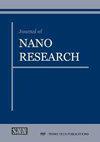反应介质 pH 值对溶胶-凝胶自燃烧法合成的纳米级铜铁氧体的结构、光学和力学性能的影响
IF 1
4区 材料科学
Q4 MATERIALS SCIENCE, MULTIDISCIPLINARY
引用次数: 0
摘要
具有尖晶石结构的纳米级混合铁氧体是一种用途广泛的材料,广泛应用于工程、生物医学和生态学等多个领域。本研究探讨了 pH 值对采用溶胶-凝胶自燃烧法合成的 CuFe2O4 尖晶石的结构、形态、电物理和机械性能的影响。研究发现,pH 值对结构的形成有显著影响,即使在凝胶形成阶段也是如此,从而塑造了合成铁氧体的后续结构和性能。X 射线衍射(XRD)分析表明,主要相(大于 90%)为立方尖晶石相,化学式为 CuFe2O4,属于 Fd3m 空间群。值得注意的是,反应介质的 pH 值对尖晶石结构的八面体和四面体亚晶格内铁离子和铜离子的分布有着深远的影响。阳离子分布的这种变化表现在合成铁氧体的磁性、机械和降解特性的显著变化上。此外,研究还深入探讨了合成的 CuFe2O4 尖晶石作为光催化剂通过光-芬顿过程降解有机染料的影响。研究表明,降解效率与铁氧体的带隙宽度和粒度密切相关。本研究旨在确定反应介质的 pH 值如何影响正在合成的纳米尺寸铁氧体的结构、形态、光学、机械和磁性特征。此外,还对合成材料降解水中有机染料的光催化能力进行了评估。铁氧体粉末通过光-芬顿过程展示了卓越的染料降解能力。降解效率在很大程度上取决于带隙宽度和颗粒大小。样品 P1 的结果最为显著,其平均粒径为 12.14 纳米。通过揭示 pH 值、结构和性能之间的复杂关系,这项研究加深了我们对纳米级混合铁氧体的设计和优化的理解。本文章由计算机程序翻译,如有差异,请以英文原文为准。
The Influence of Reaction Medium pH on the Structure, Optical, and Mechanical Properties of Nanosized Cu-Fe Ferrite Synthesized by the Sol-Gel Autocombustion Method
Nanoscale mixed ferrites with a spinel structure are highly versatile materials widely employed across diverse fields, including engineering, biomedicine, and ecology. This study explores the influence of pH on the structure, morphology, electrophysical, and mechanical properties of CuFe2O4 spinel, synthesized using the sol-gel self-combustion method. The investigation reveals that the pH level significantly impacts the structure formation, even at the gel formation stage, thereby shaping the subsequent structure and properties of the synthesized ferrite. X-ray diffraction (XRD) analysis demonstrates that the dominant phase (>90%) corresponds to the cubic spinel phase with the chemical formula CuFe2O4, belonging to the Fd3m space group. Notably, the pH of the reaction medium exerts a profound influence on the distribution of iron and copper ions within the octahedral and tetrahedral sublattices of the spinel structure. This variation in cationic distribution manifests in notable changes in the synthesized ferrite's magnetic, mechanical, and degradation properties. Furthermore, the study delves into the impact of the synthesized CuFe2O4 spinel as a photocatalyst for degrading organic dyes through the photo-Fenton process. It demonstrates that degradation efficiency is closely related to the ferrite's band gap width and particle size. This study aimed to determine how the pH of the reaction medium impacts the structure, morphology, optical, mechanical, and magnetic characteristics of the nanosized ferrites being synthesized. Furthermore, the synthesized materials were evaluated for their photocatalytic abilities in degrading organic dyes in water. The ferrite powders showcased remarkable dye degradation capabilities via the photo-Fenton process. Degradation efficiency largely hinged on the band gap width and the size of the particles. The most notable outcome was achieved with sample P1, which had particle sizes averaging 12.14 nm. By unraveling the complex relationship between pH, structure, and properties, this research enhances our understanding of the design and optimization of nanoscale mixed ferrites.
求助全文
通过发布文献求助,成功后即可免费获取论文全文。
去求助
来源期刊

Journal of Nano Research
工程技术-材料科学:综合
CiteScore
2.40
自引率
5.90%
发文量
55
审稿时长
4 months
期刊介绍:
"Journal of Nano Research" (JNanoR) is a multidisciplinary journal, which publishes high quality scientific and engineering papers on all aspects of research in the area of nanoscience and nanotechnologies and wide practical application of achieved results.
"Journal of Nano Research" is one of the largest periodicals in the field of nanoscience and nanotechnologies. All papers are peer-reviewed and edited.
Authors retain the right to publish an extended and significantly updated version in another periodical.
 求助内容:
求助内容: 应助结果提醒方式:
应助结果提醒方式:


